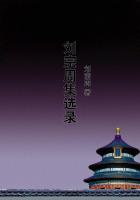Democritus, on the other hand, is right in his opinion that the eye is of water; not, however, when he goes on to explain seeing as mere mirroring. The mirroring that takes place in an eye is due to the fact that the eye is smooth, and it really has its seat not in the eye which is seen, but in that which sees. For the case is merely one of reflexion. But it would seem that even in his time there was no scientific knowledge of the general subject of the formation of images and the phenomena of reflexion. It is strange too, that it never occurred to him to ask why, if his theory be true, the eye alone sees, while none of the other things in which images are reflected do so.
True, then, the visual organ proper is composed of water, yet vision appertains to it not because it is so composed, but because it is translucent- a property common alike to water and to air. But water is more easily confined and more easily condensed than air;wherefore it is that the pupil, i.e. the eye proper, consists of water. That it does so is proved by facts of actual experience. The substance which flows from eyes when decomposing is seen to be water, and this in undeveloped embryos is remarkably cold and glistening. In sanguineous animals the white of the eye is fat and oily, in order that the moisture of the eye may be proof against freezing. Wherefore the eye is of all parts of the body the least sensitive to cold: no one ever feels cold in the part sheltered by the eyelids. The eyes of bloodless animals are covered with a hard scale which gives them similar protection.
It is, to state the matter generally, an irrational notion that the eye should see in virtue of something issuing from it; that the visual ray should extend itself all the way to the stars, or else go out merely to a certain point, and there coalesce, as some say, with rays which proceed from the object. It would be better to suppose this coalescence to take place in the fundament of the eye itself. But even this would be mere trifling. For what is meant by the 'coalescence' of light with light? Or how is it possible? Coalescence does not occur between any two things taken at random. And how could the light within the eye coalesce with that outside it? For the environing membrane comes between them.
That without light vision is impossible has been stated elsewhere;but, whether the medium between the eye and its objects is air or light, vision is caused by a process through this medium.
Accordingly, that the inner part of the eye consists of water is easily intelligible, water being translucent.
Now, as vision outwardly is impossible without [extra-organic]
light, so also it is impossible inwardly [without light within the organ]. There must, therefore, be some translucent medium within the eye, and, as this is not air, it must be water. The soul or its perceptive part is not situated at the external surface of the eye, but obviously somewhere within: whence the necessity of the interior of the eye being translucent, i.e. capable of admitting light. And that it is so is plain from actual occurrences. It is matter of experience that soldiers wounded in battle by a sword slash on the temple, so inflicted as to sever the passages of [i.e. inward from]
the eye, feel a sudden onset of darkness, as if a lamp had gone out;because what is called the pupil, i.e. the translucent, which is a sort of inner lamp, is then cut off [from its connexion with the soul].
Hence, if the facts be at all as here stated, it is clear that- if one should explain the nature of the sensory organs in this way, i.e. by correlating each of them with one of the four elements,- we must conceive that the part of the eye immediately concerned in vision consists of water, that the part immediately concerned in the perception of sound consists of air, and that the sense of smell consists of fire. (I say the sense of smell, not the organ.) For the organ of smell is only potentially that which the sense of smell, as realized, is actually; since the object of sense is what causes the actualization of each sense, so that it (the sense) must (at the instant of actualization) be (actually) that which before (the moment of actualization) it was potentially. Now, odour is a smoke-like evaporation, and smoke-like evaporation arises from fire.
This also helps us to understand why the olfactory organ has its proper seat in the environment of the brain, for cold matter is potentially hot. In the same way must the genesis of the eye be explained. Its structure is an offshoot from the brain, because the latter is the moistest and coldest of all the bodily parts.
The organ of touch proper consists of earth, and the faculty of taste is a particular form of touch. This explains why the sensory organ of both touch and taste is closely related to the heart. For the heart as being the hottest of all the bodily parts, is the counterpoise of the brain.
This then is the way in which the characteristics of the bodily organs of sense must be determined.















